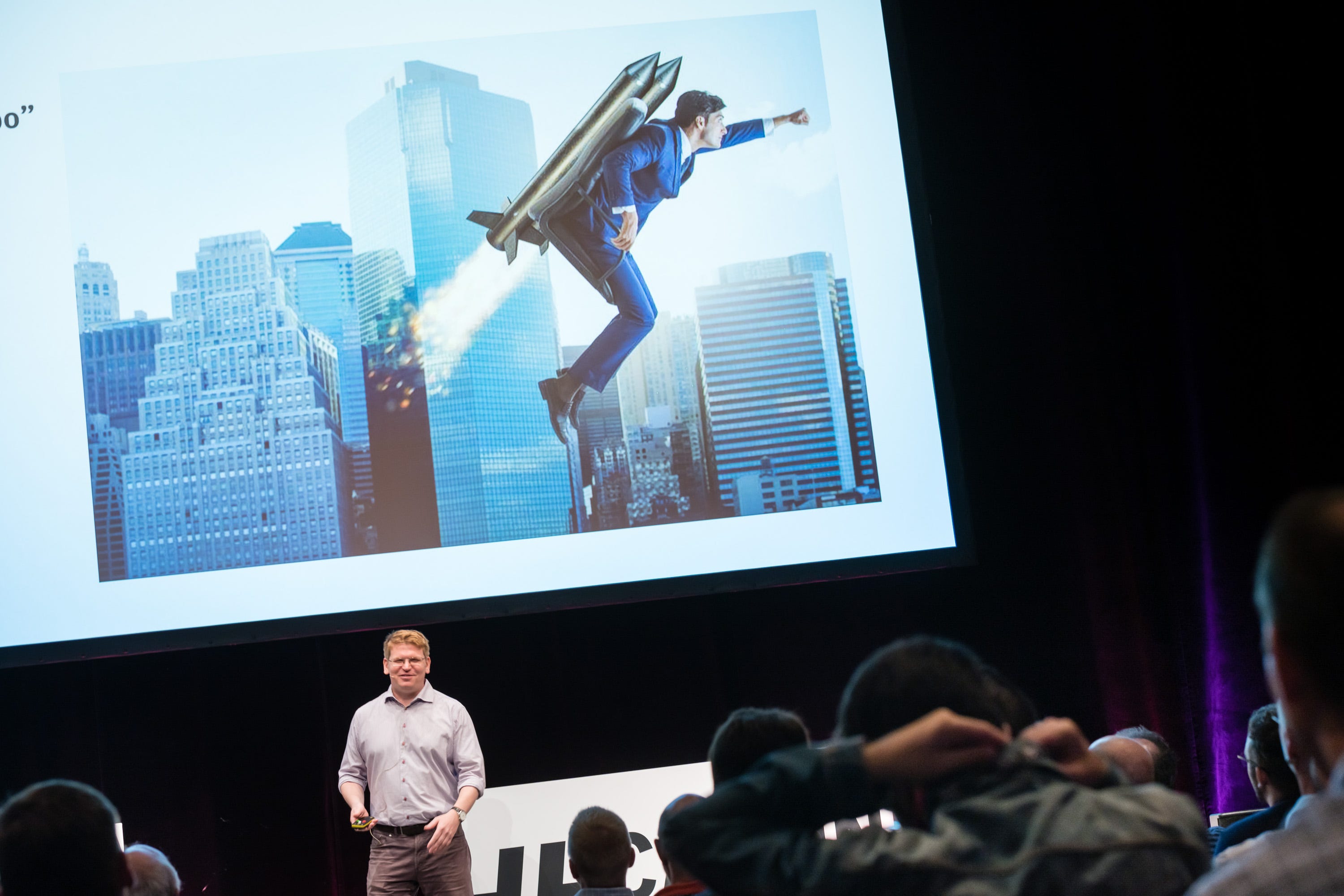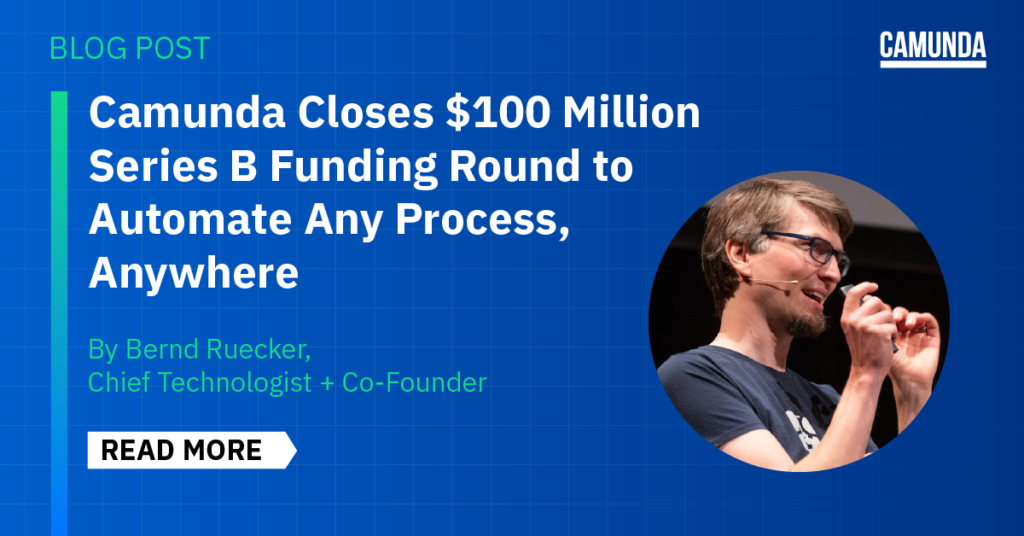I am excited to share that we just completed a €82 million (approximately $100 million) funding round led by Insight Partners. The round also included our existing investor Highland Europe from the Series A.
You can find the official press release here. In this blog post I want to comment on this funding round in my own words and briefly walk you through the story of Camunda. But first things first: Who is Camunda and what do we do?
Who is Camunda and what do we do?
Camunda provides process automation software that is used by our customers, such as Allianz, ING, Vodafone, or Atlassian, to automate processes they need tailor-made for their business. In essence, Camunda provides software to build software. For example the European retailer Zalando uses Camunda to automate their order fulfillment process. Deutsche Telekom uses Camunda to orchestrate an army of more than 2,500 RPA bots for various use cases. The insurance company Visana uses Camunda to automatically issue insurance policies within 20 minutes. Goldman Sachs has built their firm-wide workflow platform based on Camunda, and NASA uses Camunda in the context of their mars robot perseverance.
The key differentiator of Camunda, compared to competitors, is the unique combination of the following elements:
- End-to-end orchestration: Complex, tailor-made, end-to-end processes touch a lot of different systems in corporate IT landscapes and have to deal with a lot of legacy. To support this, Camunda provides an open, flexible and scalable orchestration platform to orchestrate any endpoint, person or system.
- Developer-friendly & open architecture: Developing these tailor-made process solutions requires business to go hand-in-hand with developers. Camunda brings process automation technology into the developers’ world instead of forcing proprietary methods of process automation, allowing customers to apply best practices of software engineering. Camunda further allows easy integration in any architecture and operates on any scale.
- Standards-based collaboration: Camunda uses the power of the worldwide adopted industry standards BPMN and DMN as a common language for Business and IT throughout the entire life cycle of process automation initiatives.
Customers and users regularly report that they create better customer experiences, have faster time-to-value for process automation projects, increase their business agility (to react to changes in the market) and increase their operational efficiency.
What’s the story of Camunda?
I started Camunda together with my co-founder Jakob Freund in 2008, as a company providing consultancy services around process automation. We did a lot of workshops and trainings and thus had thousands of customer contacts back then. This collided with the peak times of the BPM and SOA ideas and tools. So we were able to observe various tools in use in different companies. The common theme was that it wasn’t working out, and it was not too hard to figure out the reasons: these tools were centralized, complex, vendor-driven, and an alien to software developers (you might want to sneak into chapter 1 of Practical Process Automation to learn more about this).
We began experimenting with the open source frameworks available at the time. They were much better for developers, but they couldn’t cut it either, mainly because they were too basic, lacked important features, and required too much effort to build your own tooling around them.
At the same time, we collaborated on the development of the Business Process Model and Notation (BPMN) standard, which defines a visual but also directly executable process modeling language.
So we saw a huge opportunity: creating an open source workflow engine that was developer-friendly and fostered business-IT collaboration by using BPMN.
We validated that idea with customers, and soon made a decision to pivot with the company: in 2013 we transformed Camunda from a consulting firm into an open source process automation vendor. And our tool was the complete opposite of the common low-code BPM suites available back then, forming our own blue ocean where we could strive.
From there on we grew the company organically to more than 200 customers globally, countless open source users and almost 100 employees. All while being profitable.
In 2018 we shifted gears. We had a great product and validated our go to-market-strategy, so we accelerated by closing a Series A, which we used to back our global growth. Quoting my own words, the series A “allowed us to grow without harming things we are proud of like quality, thought-leadership, innovation, culture and much more”.
This worked out pretty nicely — we now have approximately 400 customers globally, more than 250 employees and also a global partner ecosystem with more than 100 partners worldwide. We advanced our Process Automation as a Service offering, Camunda Cloud, and innovated in all our product components, for example introducing out-of-the-box support to orchestrate RPA bots. We started the Camunda for Common Good initiative and further grew and fostered our open source community, starting the Camunda Community Hub or holding our very first Camunda Community Summit to name just a few examples.
Why a Series B?
This is where we stand now. But the market is far from being saturated. Digitalization, hyperautomation, continuous delivery and cloud native architectures — there are so many drivers that generate huge demand in the process automation market. As a result, our offering is rapidly adopted by thousands of organizations.
The series B investment allows us to lead this market, accelerate product development, and expand sales and marketing globally. Furthermore, we will benefit from Insight Partners’ huge experience in effectively scaling software companies, which is what I really look forward to.
Onwards and Upwards!

Camunda is already changing the world so much more than I could ever have dreamed of. Now, the lever will increase further. I am grateful to be part of this journey and to work with such an awesome team of great people every day — thank you all! With all of this being said, let’s get back to work and make the Camunda story an even bigger success as it already is…
Some links that you might find useful:
- Official press release
- “Camunda snares $98M Series B as process automation continues to flourish” on TechCrunch
- About Camunda and Why Camunda?
- Camunda on Twitter
To learn more about Camunda’s mission to Automate Any Process, Anywhere, watch CEO Jakob Freund’s free, on-demand presentation today:


